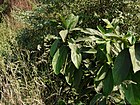Note: This is a project under development. The articles on this wiki are just being initiated and broadly incomplete. You can Help creating new pages.
Difference between revisions of "Ficus hispida - Hairy Fig"
| Line 3: | Line 3: | ||
==Uses== | ==Uses== | ||
{{Uses|Fevers}}, {{Uses|Liver problems}}.<ref name="Uses"/> | {{Uses|Fevers}}, {{Uses|Liver problems}}.<ref name="Uses"/> | ||
| + | |||
| + | ===Food=== | ||
| + | Ficus hispida can be used in Food. Tender leaves and young unripe fruits are cooked as vegetable. Ripe fruits are eaten raw. | ||
==Parts Used== | ==Parts Used== | ||
| Line 27: | Line 30: | ||
===Prabhava=== | ===Prabhava=== | ||
| + | |||
| + | ===Nutritional components=== | ||
| + | Ficus hispida Contains the Following nutritional components like - β-sitosterol, lupeol acetate, hispidine, bergapten, psoral and β-amyrin; Calcium, Copper, Iron, Magnesium, Manganese, Phosphorus, Potassium, Sodium, Zinc<ref name="Nutritional components"/> | ||
==Habit== | ==Habit== | ||
| Line 50: | Line 56: | ||
{{Propagation|Root suckers}}, {{Propagation|Seeds}}, {{Propagation|Air layering}}. | {{Propagation|Root suckers}}, {{Propagation|Seeds}}, {{Propagation|Air layering}}. | ||
| − | == | + | ==Cultivation Details== |
| − | Fig trees have a unique form of fertilization, each species relying on a single, highly specialized species of wasp that is itself totaly dependant upon that fig species in order to breed.<ref name="How to plant/cultivate"/> | + | Fig trees have a unique form of fertilization, each species relying on a single, highly specialized species of wasp that is itself totaly dependant upon that fig species in order to breed. Ficus hispida is available through January-July<ref name="How to plant/cultivate"/> |
==Commonly seen growing in areas== | ==Commonly seen growing in areas== | ||
| Line 66: | Line 72: | ||
==References== | ==References== | ||
<references> | <references> | ||
| − | |||
<ref name="chemical composition">[Chemistry]</ref> | <ref name="chemical composition">[Chemistry]</ref> | ||
| − | |||
<ref name="Leaf">[Morphology]</ref> | <ref name="Leaf">[Morphology]</ref> | ||
| − | |||
<ref name="How to plant/cultivate">[http://tropical.theferns.info/viewtropical.php?id=Ficus+hispida Cultivation]</ref> | <ref name="How to plant/cultivate">[http://tropical.theferns.info/viewtropical.php?id=Ficus+hispida Cultivation]</ref> | ||
<ref name="Uses">Indian Medicinal Plants by C.P.Khare</ref> | <ref name="Uses">Indian Medicinal Plants by C.P.Khare</ref> | ||
| + | <ref name="Nutritional components">Forest food for Northern region of western ghat pdf by Dr. Mandar N. Datar and Dr. Anuradha S. Upadhye, MACS - Agharkar Research Institute, Pune</ref> | ||
</references> | </references> | ||
Revision as of 18:14, 20 October 2021
Ficus hispida is a shrub or small tree. It can grow up to 17 metres tall with a bole up to 25cm in diameter. The tree is sometimes harvested from the wild for use as a food and medicine.
Contents
- 1 Uses
- 2 Parts Used
- 3 Chemical Composition
- 4 Common names
- 5 Properties
- 6 Habit
- 7 Identification
- 8 List of Ayurvedic medicine in which the herb is used
- 9 Where to get the saplings
- 10 Mode of Propagation
- 11 Cultivation Details
- 12 Commonly seen growing in areas
- 13 Photo Gallery
- 14 References
- 15 External Links
Uses
Food
Ficus hispida can be used in Food. Tender leaves and young unripe fruits are cooked as vegetable. Ripe fruits are eaten raw.
Parts Used
Chemical Composition
Common names
| Language | Common name |
|---|---|
| Kannada | |
| Hindi | |
| Malayalam | |
| Tamil | |
| Telugu | |
| Marathi | |
| Gujarathi | |
| Punjabi | |
| Kashmiri | |
| Sanskrit | |
| English |
Properties
Reference: Dravya - Substance, Rasa - Taste, Guna - Qualities, Veerya - Potency, Vipaka - Post-digesion effect, Karma - Pharmacological activity, Prabhava - Therepeutics.
Dravya
Rasa
Guna
Veerya
Vipaka
Karma
Prabhava
Nutritional components
Ficus hispida Contains the Following nutritional components like - β-sitosterol, lupeol acetate, hispidine, bergapten, psoral and β-amyrin; Calcium, Copper, Iron, Magnesium, Manganese, Phosphorus, Potassium, Sodium, Zinc[3]
Habit
Identification
Leaf
| Kind | Shape | Feature |
|---|---|---|
Flower
| Type | Size | Color and composition | Stamen | More information |
|---|---|---|---|---|
| {{{5}}} |
Fruit
| Type | Size | Mass | Appearance | Seeds | More information |
|---|---|---|---|---|---|
Other features
List of Ayurvedic medicine in which the herb is used
Where to get the saplings
Mode of Propagation
Root suckers, Seeds, Air layering.
Cultivation Details
Fig trees have a unique form of fertilization, each species relying on a single, highly specialized species of wasp that is itself totaly dependant upon that fig species in order to breed. Ficus hispida is available through January-July[5]
Commonly seen growing in areas
Open places, Swamp forests, Along rivers, Along streams.
Photo Gallery
References
External Links
- Ayurvedic Herbs known to be helpful to treat Fevers
- Ayurvedic Herbs known to be helpful to treat Liver problems
- Herbs with Fruits used in medicine
- Habit - Evergreen tree
- Index of Plants which can be propagated by Root suckers
- Index of Plants which can be propagated by Seeds
- Index of Plants which can be propagated by Air layering
- Herbs that are commonly seen in the region of Open places
- Herbs that are commonly seen in the region of Swamp forests
- Herbs that are commonly seen in the region of Along rivers
- Herbs that are commonly seen in the region of Along streams
- Herbs
- Pages without herbs images




